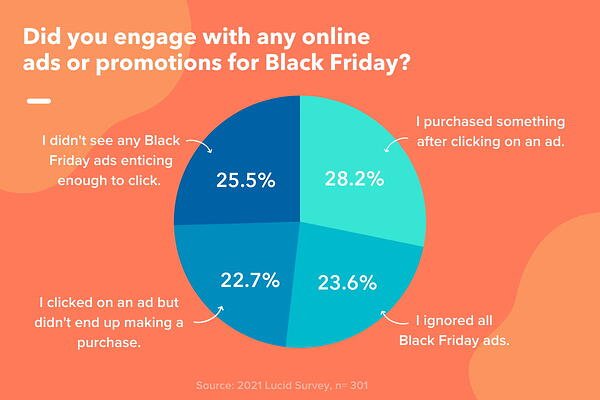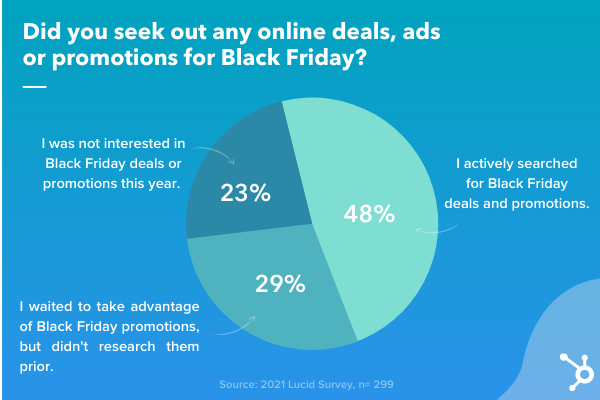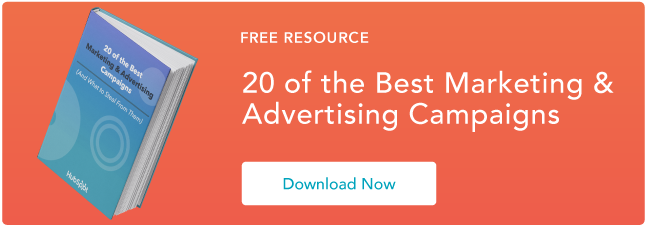After 2020, there were big expectations for what 2021 could bring. Some predicted lower Black Friday sales as supply chains struggle to meet demand. Others said 2021 would bring record numbers.
As an advertiser, you might want to learn more about growing online purchasing behaviors – and how you can leverage them in 2022.
Below, we’ll highlight what we learned from polling 300+ consumers after this Black Friday. Then, we’ll present a few consumer behavior predictions you’ll need to know about when determining your 2022 Black Friday ad strategy.
What We Learned About Black Friday Shoppers in 2021
To help marketers discover more about the consumer behaviors behind Black Friday’s 2021 results, I surveyed a pool of more than 300 people using Lucid Software. The goal was to learn what led them to engage with or purchase products in Black Friday ads.
Here’s what we learned from our results.
1. Social media was the leading driver for ad engagement.
With Black Friday deals comes an inundation of Black Friday ads throughout all forms of media. It’s no surprise that millions of people shopped on Black Friday – but which ad strategies actually led to purchases?
When I asked participants, “Did you engage with any online ads or promotions for Black Friday?” 56% said they engaged with one or more ads in some way, while only 26% said they ignored them.

We also found that social media was the number one place consumers engaged with ads, with 54% of consumers surveyed clicking on ads they saw on a social network.
Social media is a big revenue driver when it comes to Black Friday ads and the opportunities it offers continue to expand. Let’s take a look at Instagram for example.
You can discover a brand, scroll through their profile, see a product you like, and complete a purchase without ever leaving the platform.
With so many social media platforms offering ecommerce features, brands can attract shoppers at every stage of the buyer’s journey and consumers can experience a seamless shopping experience. It’s a win-win.
From an advertising perspective, this is a big indication that brands should be well prepared for social media ads as Black Friday approaches.
Instead of waiting for the week before Black Friday, where timelines are already flooded with ads, consider starting early and you may get better results.
That said, having an online presence beyond social media is also important. Our survey found that while most of the ads consumers clicked on came from social media, 23% clicked on ads they saw on brand websites and 22% on search engines.
With this in mind, it’s important to diversify your ad channels, as each has the potential to drive revenue.
2. Consumers showed interest in technology and electronic deals.
Aside from the ad’s location, the product or service advertised could have played a role in an audience’s level of engagement.
To get an idea of which products were most popular, I asked survey participants, “Which industries were you most interested in shopping?” 49% answered “Electronics and appliances.”
This mirrors data from SEMrush, which shows that the most popular and searched products include laptops, televisions, watches, headphones, video games, and cellphones.
Amazon reported that its top-selling items were also electronics: Apple Airpods, the Fire TV Stick, the Echo Dot, smart lightbulbs, and more.
This is great news for brands that fall within this industry, as Black Friday is a great opportunity to drive traffic to your products.
3. Consumers are shopping more online.
40% of Lucid survey respondents said they shopped exclusively online, with only 7% doing an even mix of online and in-person.
Although traffic at retail stores is up almost 50% from last year, it’s still not back to pre-pandemic numbers, according to a CNBC report.
Ecommerce brands are benefiting from this recent shift, with Shopify reporting a 21% increase in Black Friday/Cyber Monday sales year-over-year. Globally, the platform reached peak sales of $3.1 million per minute on Black Friday.
However, what data does suggest is that online ads can drive shoppers to head to stores in person. Fiffy-four percent of consumers surveyed on Lucid said that they visited a store to grab a deal they saw in an ad online.`
3 Predictions for Black Friday 2022
1. Brands with a strong social strategy will outperform those without one.
Our survey results and mounting research continues to show the growing importance of developing or constantly improving a web presence.
And as we mentioned, an online web presence might not just be a nice perk for your customers. It might result in ROI for your brand, especially on Black Friday.
Growing an online presence doesn’t have to be expensive and daunting.
For example, if you’re just dipping your toes into online marketing, you could start with free strategies like building a social media profile, launching a basic website, starting a marketing email, or creating a Google My Business for your store.
Then, once you’re comfortable, experiment with larger investments such as buying online ads.
The strategies above will allow people across the web to learn more about your brand, offerings, or services. These tactics could also make it easier for prospects to find you when they’re researching products or services in your industry.
2. Consumers will start shopping earlier.
In previous years, shoppers waited closer to Thanksgiving weekend to start shopping. This year, things are changing.
According to the National Retail Federation, this early shopping trend has been rising since 2011.
They report that most consumers (61%) started shopping as early as Halloween this year, almost a month before Black Friday. In fact, some completed roughly a third of their holiday shopping by the beginning of the month.
In addition, shoppers aren’t just waiting to stumble upon ads, nearly 48% of Lucid respondents surveyed said they actively searched for Black Friday deals and promotions.

For advertisers, this means launching ads early to reach consumers as they’re starting to shop for the holiday season.
3. Shoppers will be more intentional about where they spend.
In early 2021, Intuit ran a survey of over 1,000 Americans and found that 70% are supporting local businesses.
The survey also revealed that Millennials and Gen Z are more likely to support local businesses by only shopping online (45 percent).
This intentionality was also apparent during Black Friday 2021. Among the consumers surveyed in our Lucid poll, 63% said they either prioritized shopping from small or local brands or did a combination of small to large businesses.
5 Tips for Creating Effective Black Friday Ads
1. Plan (and launch) early.
This year, consumers started holiday shopping early.
We can’t predict with full accuracy what things will look like next year. So, in absence of knowledge, it’s better to stay ready so you don’t have to get ready.
In other words, don’t start planning your promotion strategy in early November. You want to give your team enough time to plan an effective strategy that will reach your target audience at the right place and at the right time.
You’ll need enough time to craft a plan, develop the strategy, build the creative assets, and launch the campaign. You’ll also need to account for any obstacles you may encounter along the way.
2. Highlight how a service or product can solve for your customer.
Your ads should aim to educate ideal customers about your offerings, how they can help them, or why they might need them in their daily lives.
But, how do you convey that your offerings are valuable, important, or necessities when you don’t actually sell an essential product? Although it can take some creativity, it is possible to do this.

Above is an example of Twitter content from InfoArmor, an information security service owned by Allstate.
In the tweet, InfoArmor shared a blog post about the dangers of information security when working remotely and how InfoArmor could protect remote employee information.
3. Diversify your promotion channels.
We mentioned that social media is a huge revenue generator during Black Friday.
However, that doesn’t mean it’s the only channel you should leverage to attract shoppers. In fact, you should promote your ads across all channels to maximize your reach.
Have a newsletter? Share your offers there. You could also consider running a Google Ads campaign.
Regardless of which online platforms you embrace, be sure to create content that speaks to those customers, rather than just placing a basic ad on every website you can access.
By creating content that’s tailored to platforms your customers use, you’ll increase the likelihood of catching their eyes as they scroll through endless web pages, feeds, or email inboxes. And, once you grab their attention, you can use that content to highlight your value proposition in an entertaining or interesting way.
For example, if you’re creating an ad for Instagram, it might be tempting to just use a picture of the ad you made for a website or newspaper on with a basic caption.
But, that might not be engaging for people scrolling through their feeds looking for valuable product information or entertaining content. Instead, consider creating a short marketing video or a series of photos of customers with your product to better engage this audience.
Below is a great example of a Black Friday post that could also work well as an ad on Instagram. The post shows a video demo of someone from Hair Vivi putting on one of the brand’s wigs.
While the video shows viewers how easy it is to put on the wig, the caption also highlights the product’s value and the company’s Black Friday deals.
4. Present deals, sales, or affordable offers.
Aside from aiming to buy products with the best value, budget-conscious shoppers will also be looking for the best deals this holiday season.
If you can offer a deal or sale on your product or offering, embrace that information in your advertising.
Here’s a great ad from Walmart that highlights all the online deals they’ll be offering this year:
 Along with the ad highlighting a bunch of great deals and alternatives for Black Friday in-person sales, the ad is also interesting because it’s interactive online but formatted so it can also work as a static print ad if needed.
Along with the ad highlighting a bunch of great deals and alternatives for Black Friday in-person sales, the ad is also interesting because it’s interactive online but formatted so it can also work as a static print ad if needed.
Aside from the ad above, Walmart has created content with a similar aesthetic and deal-oriented message for social media platforms like Facebook. Here’s a screenshot of featured content on its Facebook Business page.

5. Embrace video marketing.
In our 2021 State of Marketing Report, we found that video is the leading form of marketing content used across industries. And, with Gen-Z and millennials embracing video more than ever for product discovery, this format becomes more of a low-hanging fruit each year.
If you think video marketing is only for big brands, think again.
In the last year, we’ve seen all sorts of small and large brands affordably embrace video to attract and nurture leads.
Here’s one great example of a startup demo video created by Beauty Bakerie.
While the content allows viewers to see what the products will look like in real life, Cashmere, the brand’s CEO – Cashmere Nicole Carillo – gives instructions on how to use it so they’ll also know just how easy it is to add to their daily beauty routine.
Every Black Friday is an opportunity to learn more about your target audience. Pay attention to what works, what doesn’t, and look out for trends that will help you improve your ad strategy.
Editor’s Note: This blog post was originally published in December 2019 but was updated for freshness and comprehensiveness.
![]()


